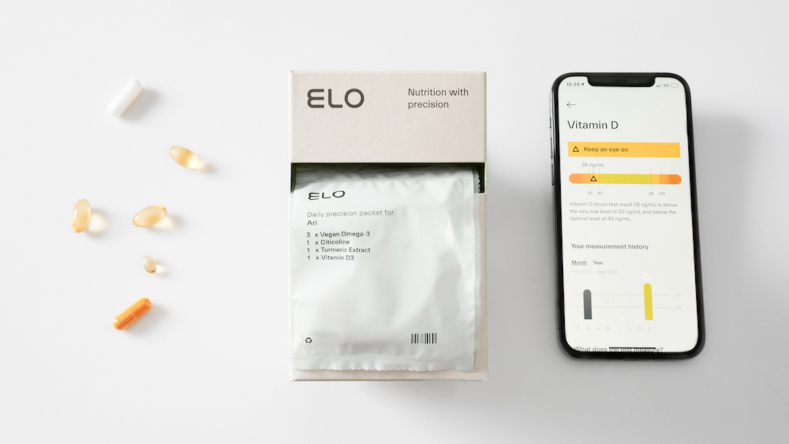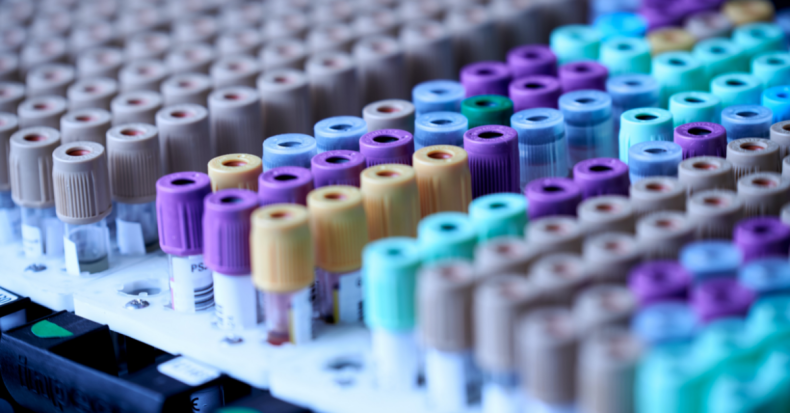How to optimize your vitamin D levels
90% of Elo members start with low vitamin D, which has a critical impact on bone health, immune function, and more. Learn more about improving your vitamin D levels through nutrition, supplementation, and sunshine.

Having a well-rounded diet is important for overall health, and vitamin D is no exception. Vitamin D can be synthesized by our skin from exposure to UVB rays, however, few of us get enough sun to make adequate vitamin D. Moreover, vitamin D is found in only a few foods, leaving most of us short on D.
So, why is it important to consume and how does it affect your body? Let’s first start off by discussing the role of vitamin D.

What is vitamin D?
Vitamin D3 (aka cholecalciferol) is often referred to as the “sunshine vitamin,” as it is produced endogenously in the skin when you are exposed to UVB rays.
Vitamin D can also be obtained through diet either as either D2 or D3. Vitamin D2 (ergocalciferol) is present in plants and yeast, while vitamin D3 comes from animal sources such as oily fish.
Since many people do not get enough daylight year-round to produce adequate vitamin D and it’s only found in a few foods, supplementation may be necessary to meet vitamin D needs [1,14]. While both vitamin D2 and vitamin D3 supplements raise overall vitamin D levels, research notes that supplementation with vitamin D3 twice a week for 5 weeks was more effective in raising vitamin D levels in adults than the same amount of vitamin D2 [13].
The Recommended Dietary Allowance (RDA) for people between the ages of 1 and 70 is 600 IU per day, and for adults over 70 the RDA is 800 IU per day [1]. However, recent research shows that Vitamin D supplementation can be used at 5,000 IU/day (and up to 10,000 IU/day) without any adverse effects [15].
Vitamin D effects on health
Vitamin D is a fat-soluble vitamin involved in bone health, immune support, cell growth and development, and glucose metabolism. Let’s explore some of these in more detail.

Bone health
Vitamin D increases calcium absorption in the gut and plays an important part in maintaining bone health by regulating calcium and phosphorus. Low vitamin D can contribute to the development of osteoporosis, rickets, and other bone diseases [1].
Immune health
Studies have shown a link between vitamin D deficiency and increased risk of infections and higher rates of autoimmune disease [1,3]. This is likely due to the important role vitamin D plays in improving immune function, reducing inflammation, and modulating growth and development. Though more evidence is needed, observational studies have also found a link between vitamin D deficiency and increased COVID-19 severity and mortality [1].
Glucose metabolism
In addition to bone health and an improved immune system, adequate vitamin D appears to help protect against type 2 diabetes. Studies suggest that low vitamin D status contributes to elevated glycosylated hemoglobin (HbA1c), a marker of insulin resistance [9].

How is vitamin D measured?
You can determine your vitamin D levels by taking a blood test that measures a form of vitamin D known as 25(OH)D, or calcidiol. Assessing 25(OH)D reflects vitamin D produced from sun exposure as well as that obtained from food and supplements. Vitamin D levels greater than or equal to 40 nmol/L are generally considered adequate for bone and overall health for most individuals [4].
What factors influence vitamin D levels?
Now that we’ve established the importance of vitamin D, let’s discuss factors that can help or hinder absorption.

UV radiation exposure
Since vitamin D is produced through exposure to sunlight, factors that affect UV radiation exposure can prevent us from getting adequate vitamin D. These factors include season, time of day, clouds, smog, and sunscreen, as well as skin melanin content [4]. Those with darker skin may need more sun exposure than those with pale skin to produce enough vitamin D.
Age
Endogenous vitamin D production in skin decreases with age, putting the elderly at a higher risk for vitamin D deficiency [1].
Genetics
Genetics can also impact vitamin D absorption and utilization. According to studies, there are 35 genes associated with deficiency of vitamin D, and the more of these genes a person carries, the greater the risk of having low vitamin D levels [10]. One of these genes is referred to as the VDR (vitamin D receptor) genetic variant. The VDR protein regulates the activity of vitamin D-responsive genes and helps control calcium and phosphate absorption [11]. If you have the VDR genetic variant, your body will have a difficult time naturally producing vitamin D, and supplementation may be necessary [12].
Medical conditions
Conditions that impact the gastrointestinal tract (such as celiac disease, cystic fibrosis, and Crohn’s disease),kidney and/or liver can reduce your body’s ability to absorb vitamin D. Weight loss surgery and radiation treatments may also impair absorption, and supplementation may be necessary to maintain adequate vitamin D levels [1]. Obesity and some medications including laxatives, steroids, and cholesterol-lowering drugs are also factors that can negatively impact your vitamin D levels.
How to optimize your vitamin D levels
Though there are several factors that can impair absorption, there are also many practices you can incorporate to optimize vitamin D levels.
Spend time outside
One thing you can do to optimize your vitamin D levels is enjoy more time outside. Sunscreen blocks vitamin D synthesis, but if you plan on being outside for longer periods of time, sunscreen with an SPF of at least 30 should be applied to prevent sunburn and skin cancer [1,7].

Eat vitamin D-rich foods and/or consider a supplement
Consuming vitamin D-rich foods such as fatty fish, mushrooms, egg yolks, and fortified dairy and grains can help increase your levels. However, many people may need to take a supplement in order to meet their needs. Since vitamin D is a fat-soluble vitamin, taking your supplement with a fat source such as avocado, nuts, and seeds, or full-fat dairy products may enhance absorption [5,6]. Some studies also suggest that consuming adequate amounts of magnesium is essential for activating vitamin D, so supplementation with magnesium may be helpful if your levels are low [2,8].
To determine whether you need a vitamin D supplement and to figure out the proper dosage, consult your healthcare provider.
Summary
Vitamin D is a fat-soluble vitamin that plays an important role in bone health, immune support, cell growth and development, and glucose metabolism. While there are several factors that can impair absorption, you can optimize vitamin D levels by spending time outside, eating foods rich in vitamin D, and supplementing vitamin D3. Maintaining (and monitoring) your vitamin D levels can improve your body’s health and overall function.
Disclaimer: The text, images, videos, and other media on this page are provided for informational purposes only and are not intended to treat, diagnose or replace personalized medical care.
Key takeaways
Vitamin D is a fat-soluble vitamin involved in immune support, bone health, cell growth and development, and glucose metabolism.
Since vitamin D is produced through exposure to sunlight, factors that affect UV radiation exposure can prevent you from getting adequate exposure.
Conditions that impact the gastrointestinal tract (such as celiac disease, cystic fibrosis, and Crohn’s disease), kidney, and/or liver can reduce your body’s ability to absorb vitamin D.
Spending time outside, consuming vitamin D rich foods such as fatty fish, egg yolks and fortified dairy, and supplementation can help raise vitamin D levels and achieve sufficiency.
References
Chang, S. W., & Lee, H. C. (2019). Vitamin D and health - The missing vitamin in humans. Pediatrics and neonatology, 60(3), 237–244.
https://doi.org/10.1016/j.pedneo.2019.04.007
Goltzman D. (2018). Functions of vitamin D in bone. Histochemistry and cell biology, 149(4), 305–312.
https://doi.org/10.1007/s00418-018-1648-y
Martens, P. J., Gysemans, C., Verstuyf, A., & Mathieu, A. C. (2020). Vitamin D's Effect on Immune Function. Nutrients, 12(5), 1248.
https://doi.org/10.3390/nu12051248
U.S. Department of Health and Human Services. (2021, March 26). Vitamin D Fact Sheet for Health Professionals. NIH Office of Dietary Supplements.
https://ods.od.nih.gov/factsheets/VitaminD-HealthProfessional/
.Ali N. (2020). Role of vitamin D in preventing of COVID-19 infection, progression and severity. Journal of infection and public health, 13(10), 1373–1380.
https://doi.org/10.1016/j.jiph.2020.06.021
Maurya, V. K., & Aggarwal, M. (2017). Factors influencing the absorption of vitamin D in GIT: an overview. Journal of food science and technology, 54(12), 3753–3765.
https://doi.org/10.1007/s13197-017-2840-0
.Holick M. F. (2020). Sunlight, UV Radiation, Vitamin D, and Skin Cancer: How Much Sunlight Do We Need?. Advances in experimental medicine and biology, 1268, 19–36.
https://doi.org/10.1007/978-0-387-77574-6_1
Uwitonze, A. M., & Razzaque, M. S. (2018). Role of Magnesium in Vitamin D Activation and Function. The Journal of the American Osteopathic Association, 118(3), 181–189.
https://doi.org/10.7556/jaoa.2018.037
Dalgard, C., Petersen, M. S., Weihe, P., & Grandjean, P. (2011). Vitamin D Status in Relation to Glucose Metabolism and Type 2 Diabetes in Septuagenarians. Diabetes Care, 34(6), 1284–1288.
https://doi.org/10.2337/dc10-2084
Sepulveda-Villegas, M., Elizondo-Montemayor, L., & Trevino, V. (2020). Identification and analysis of 35 genes associated with vitamin D deficiency: A systematic review to identify genetic variants. The Journal of steroid biochemistry and molecular biology, 196, 105516. https://doi.org/10.1016/j.jsbmb.2019.105516
National Center for Biotechnology Information (2021). PubChem Gene Summary for NCBI Gene 7421, VDR - vitamin D receptor (human). Retrieved June 16, 2021 from
https://pubchem.ncbi.nlm.nih.gov/gene/VDR/human
.Medeiros, J.F.P., de Oliveira Borges, M.V., Soares, A.A. (2020). The impact of vitamin D supplementation on VDR gene expression and body composition in monozygotic twins: randomized controlled trial. Sci Rep 10, 11943.
https://doi.org/10.1038/s41598-020-69128-2
Shieh, A., Chun, R. F., Ma, C., Witzel, S., Meyer, B., Rafison, B., Swinkels, L., Huijs, T., Pepkowitz, S., Holmquist, B., Hewison, M., & Adams, J. S. (2016). Effects of High-Dose Vitamin D2 Versus D3 on Total and Free 25-Hydroxyvitamin D and Markers of Calcium Balance. The Journal of clinical endocrinology and metabolism, 101(8), 3070–3078.
https://doi.org/10.1210/jc.2016-1871
Amrein, K., Scherkl, M., Hoffmann, M. (2020). Vitamin D deficiency 2.0: an update on the current status worldwide. Eur J Clin Nutr 74, 1498–1513.
https://doi.org/10.1038/s41430-020-0558-y
Ghanaati, S., Choukroun, J., Volz, U., Hueber, R., Mourão, C. F. de, Sader, R., Kawase-Koga, Y., Mazhari, R., Amrein, K., Meybohm, P., & Al-Maawi, S. (2020). One hundred years after Vitamin D discovery: Is there clinical evidence for supplementation doses? International Journal of Growth Factors and Stem Cells in Dentistry, 3(1), 3.
https://doi.org/10.4103/gfsc.gfsc_4_20






